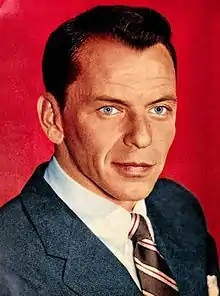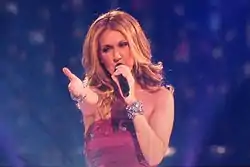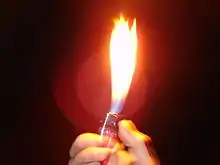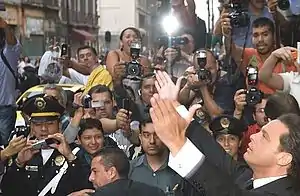Sentimental ballad
A sentimental ballad is an emotional style of music that often deals with romantic and intimate relationships, and to a lesser extent, loneliness, death, war, drug abuse, politics and religion, usually in a poignant but solemn manner.[1] Ballads are generally melodic enough to get the listener's attention.[2]
Sentimental ballads are found in most music genres, such as pop, R&B, soul, country, folk, rock and electronic music.[3] Usually slow in tempo, ballads tend to have a lush musical arrangement which emphasizes the song's melody and harmonies. Characteristically, ballads use acoustic instruments such as guitars, pianos, saxophones, and sometimes an orchestral set. Many modern mainstream ballads tend to feature synthesizers, drum machines and even, to some extent, a dance rhythm.[4]
Sentimental ballads had their origins in the early Tin Pan Alley music industry of the later 19th century.[5] Initially known as "tear-jerkers" or "drawing-room ballads", they were generally sentimental, narrative, strophic songs published separately or as part of an opera, descendants perhaps of broadside ballads. As new genres of music began to emerge in the early 20th century, their popularity faded, but the association with sentimentality led to the term ballad being used for a slow love song from the 1950s onwards.[6]
History
Early history
Sentimental ballads have their roots from medieval French chanson balladée or ballade, which were originally "danced songs". Ballads were particularly characteristic of the popular poetry and song of the British Isles from the later medieval period until the 19th century. They were widely used across Europe, and later in the Americas, Australia and North Africa.[7][8][9] As a narrative song, their theme and function may originate from Scandinavian and Germanic traditions of storytelling.[10] Musically they were influenced by the Minnesinger.[11] The earliest example of a recognizable ballad in form in England is "Judas" in a 13th-century manuscript.[12] A reference in William Langland's Piers Plowman indicates that ballads about Robin Hood were being sung from at least the late 14th century and the oldest detailed material is Wynkyn de Worde's collection of Robin Hood ballads printed about 1495.[13]
18th century – early 20th century

Ballads at this time were originally composed in couplets with refrains in alternate lines. These refrains would have been sung by the dancers in time with the dance.[16] In the 18th century, ballad operas developed as a form of English stage entertainment, partly in opposition to the Italian domination of the London operatic scene.[17] In America a distinction is drawn between ballads that are versions of European, particularly British and Irish songs, and 'Native American ballads', developed without reference to earlier songs. A further development was the evolution of the blues ballad, which mixed the genre with Afro-American music.[18]
In the late 19th century, Danish folklorist Svend Grundtvig and Harvard professor Francis James Child attempted to record and classify all the known ballads and variants in their chosen regions.[12] Since Child died before writing a commentary on his work it is uncertain exactly how and why he differentiated the 305 ballads printed that would be published as The English and Scottish Popular Ballads.[19] There have been many different and contradictory attempts to classify traditional ballads by theme, but commonly identified types are the religious, supernatural, tragic, love ballads, historic, legendary and humorous.[10]
By the Victorian era, ballad had come to mean any sentimental popular song, especially so-called "royalty ballads".[20] Some of Stephen Foster's songs exemplify this genre. By the 1920s, composers of Tin Pan Alley and Broadway used ballad to signify a slow, sentimental tune or love song, often written in a fairly standardized form. Jazz musicians sometimes broaden the term still further to embrace all slow-tempo pieces.[21] Notable sentimental ballads of this period include, "Little Rosewood Casket" (1870), "After the Ball" (1892), and "Danny Boy" (1913).[22]
1950s–1960s

Popular sentimental ballad vocalists in this era include Frank Sinatra, Ella Fitzgerald, Andy Williams, Johnny Mathis, Connie Francis and Perry Como. Their recordings were usually lush orchestral arrangements of current or recent rock and roll or pop hit songs. The most popular and enduring songs from this style of music are known as "pop standards" or (where relevant) "American standards". Many vocalists became involved in 1960s' vocal jazz and the rebirth of swing music, which was sometimes referred to as "easy listening" and was, in essence, a revival of popularity of the "sweet bands" that had been popular during the swing era, but with more emphasis on the vocalist and the sentimentality.[24]
1970s
Soft rock, a subgenre that mainly consists of ballads, was derived from folk rock in the late 1960s, using acoustic instruments and putting more emphasis on melody and harmonies. Major sentimental ballad artists of this decade included Barbra Streisand, Nana Mouskouri, Elton John, Engelbert Humperdinck, Carole King, Cat Stevens and James Taylor. By the early 1970s, softer ballad songs by the Carpenters, Anne Murray, John Denver and Barry Manilow began to be played more often on "Top 40" radio.[25]
Some rock-oriented acts such as Queen and the Eagles also produced ballads.[1][26][27]
When the word ballad appears in the title of a song, as for example in the Beatles' "The Ballad of John and Yoko" (1969) or Billy Joel's "The Ballad of Billy the Kid" (1974), the folk music sense is generally implied. The term ballad is also sometimes applied to strophic story-songs more generally, such as Don McLean's "American Pie" (1971).[28][29][30]
1980s–1990s

Prominent artists who made sentimental ballads in the 1980s include Stevie Wonder, Lionel Richie, Peabo Bryson, Barry White, Luther Vandross and George Michael.[32]
The 1990s mainstream pop/R&B singers such as Boyz II Men, Celine Dion, Shania Twain, Whitney Houston and Mariah Carey.[33]
Newer female singer-songwriters such as Sarah McLachlan, Natalie Merchant, Jewel, Melissa Etheridge and Sheryl Crow also broke through on the AC chart during this time owing to their ballad-sound.[34]
2000s
A popular trend in the early 2000s was remixing dance music hits into acoustic ballads (for example, the "Candlelight Mix" versions of "Heaven" by DJ Sammy, "Listen To Your Heart" by D.H.T., and "Everytime We Touch" by Cascada).[35]
2010s
In the 2010s, indie musicians like Imagine Dragons, Mumford & Sons, Of Monsters and Men, the Lumineers and Ed Sheeran had indie songs that crossed over to the adult contemporary charts, due to their ballad-heavy sound.[36]
Genres
Jazz and traditional pop
Most pop standard and jazz ballads are built from a single, introductory verse, usually around 16 bars in length, and they end on the dominant – the chorus or refrain, usually 16 or 32 bars long and in AABA form (though other forms, such as ABAC, are not uncommon). In AABA forms, the B section is usually referred to as the bridge; often a brief coda, sometimes based on material from the bridge, is added, as in "Over the Rainbow".[37][38]
Pop and R&B ballads
The most common use of the term "ballad" in modern pop and R&B music is for an emotional song about romance, breakup and/or longing.[22] The singer would usually lament an unrequited or lost love, either where one party is oblivious to the existence of the other, where one party has moved on, or where a romantic affair has affected the relationship.[39][40]
Power ballads
| Power ballad | |
|---|---|
 | |
| Stylistic origins | |
| Cultural origins | Early 1970s |
| Other topics | |
Simon Frith, the British sociomusicologist and former rock critic, identifies the origins of the power ballad in the emotional singing of soul artists, particularly Ray Charles, and the adaptation of this style by performers such as Eric Burdon, Tom Jones, and Joe Cocker to produce slow-tempo songs often building to a loud and emotive chorus backed by drums, electric guitars, and sometimes choirs.[43] According to Charles Aaron, power ballads came into existence in the early 1970s, when rock stars attempted to convey profound messages to audiences.[44]
Aaron argues that the power ballad broke into the mainstream of American consciousness in 1976 as FM radio gave a new lease of life to earlier songs such as Badfinger's "Without You", Paul McCartney's "Maybe I'm Amazed", Led Zeppelin's "Stairway to Heaven", Aerosmith's "Dream On", and Lynyrd Skynyrd's "Free Bird".[44] The Carpenters' "Goodbye to Love" has also been identified as a prototype of the power ballad.[45] Later power ballads include Nazareth's "Love Hurts" (1974);[43] Foreigner's "I Want to Know What Love Is" (1984);[46] Heart's "What About Love" (1985) and "Alone" (1987);[47] Whitesnake's "Is This Love" (1987); Poison's "Every Rose Has Its Thorn" (1988) and "Something to Believe In" (1990); Metallica's "One" (1988), "The Unforgiven" (1991) and "Nothing Else Matters" (1991); Scorpions' "Wind of Change" (1990);[46] Guns N' Roses' "November Rain" (1991);[48] and Aerosmith's "I Don't Want to Miss a Thing" (1998).[46]
Latin ballad
Latin ballad refers to the ballad derived from bolero that originated in the early-1960s in Latin America and Spain.
One of the most well-known Latin ballad singers of the 1970s and 1980s was José José. Known as "El Principe de La Cancion" (The Prince of the Song), he sold over 40 million albums in his career and became a huge influence to later ballad singers such as Cristian Castro, Alejandro Fernández, Nelson Ned, Manuel Mijares and Lupita D'Alessio.[49]
See also
- Threnody
- Torch song
- List of Irish ballads
- List of rock ballads
- Slow dance
Notes
- J. M. Curtis, Rock Eras: Interpretations of Music and Society, 1954-1984 (Popular Press, 1987), p. 236.
- Bronson, B., H. (1969). The Ballad as Song. Los Angeles: University of California Press
- Ord, J. (1990). Bothy Songs and Ballads. Edinburgh: John Donald.
- "Pop Music - What Is Pop Music - A Definition and Brief History". Top40.about.com. September 7, 2012. Retrieved October 3, 2012.
- P. Buckley, The Rough Guide to Rock (Rough Guides, 3rd edn., 2003), p. 378.
- Witmer. See also Middleton (I,4,i).
- W. Apel, Harvard Dictionary of Music (Harvard, 1944; 2nd edn., 1972), p. 70.
- A. Jacobs, A Short History of Western Music (1972, Penguin, 1976), p. 21.
- W. Apel, Harvard Dictionary of Music (1944, Harvard, 1972), pp. 70-72.
- J. E. Housman, British Popular Ballads (1952, London: Ayer Publishing, 1969), p. 15.
- A. Jacobs, A Short History of Western Music (Penguin 1972, 1976), p. 20.
- A. N. Bold, The Ballad (Routledge, 1979), p. 5.
- B. Sweers, Electric Folk: The Changing Face of English Traditional Music (Oxford: Oxford University Press, 2005), p. 45.
- "'After the Ball': Lyrics from the Biggest Hit of the 1890s", History Matters
- Smith, Kathleen E. R. (2003). God Bless America: Tin Pan Alley Goes to War. The University Press of Kentucky. p. 91. ISBN 0813122562.
- "Popular Ballads", The Broadview Anthology of British Literature: The Restoration and the Eighteenth Century, p. 610.
- M. Lubbock, The Complete Book of Light Opera (New York: Appleton-Century-Crofts, 1962) pp. 467-68.
- D. Head and I. Ousby, The Cambridge Guide to Literature in English (Cambridge University Press, 2006), p. 66.
- T. A. Green, Folklore: An Encyclopedia of Beliefs, Customs, Tales, Music, and Art (ABC-CLIO, 1997), p. 352.
- Child, F., J. (1898). The English and Scottish Popular Ballads, Boston: Houghton, Mifflin and Co
- Temperley (II,2).
- N. Cohen, Folk Music: a Regional Exploration (Greenwood, 2005), p. 297.
- Fusilli, Jim (May 13, 2008). "Sinatra as Idol – Not Artist". The Wall Street Journal. Retrieved May 15, 2008.
- "Project MUSE - Lounge Caravan: A Selective Discography". Muse.jhu.edu. February 23, 2005. doi:10.1353/not.2005.0059. Retrieved October 3, 2012.
- "10 Best Soft Rock Ballads". Made Man. Archived from the original on November 13, 2010. Retrieved December 6, 2010. "Journey fans can easily list a dozen soft rock ballads from the band..."
- Soft Rock. "Soft Rock : Significant Albums, Artists and Songs, Most Viewed". AllMusic. Retrieved January 9, 2013.
- "Soft Rock - Profile of the Mellow, Romantic Soft Rock of the '70s and Early '80s". 80music.about.com. April 12, 2012. Retrieved January 9, 2013.
- D. R. Adams, Rock 'n' roll and the Cleveland Connection Music of the Great Lakes (Kent State University Press, 2002), ISBN 0-87338-691-4, p. 70.
- C. H. Sterling, M. C. Keith, Sounds of Change: a History of FM broadcasting in America (UNC Press, 2008), pp. 136-7.
- "Journey: The band who did not stop believing". BBC News. November 12, 2010. Retrieved December 6, 2010.
- Erlewine, Stephen Thomas. Let's Talk About Love: Album review. Allmusic. Retrieved 12 October 2009.
- Sweeting, Bernadette McNulty, Thomas H. Green and Adam (April 15, 2015). "50 best love songs of the 1980s" – via www.telegraph.co.uk.
- Roberts, Amy. "This '90s Love Song Playlist Is The Only One You'll Ever Need". Bustle.
- Hyatt, Wesley (1999). The Billboard Book of Number One Adult Contemporary Hits. New York City: Billboard Books. ISBN 978-0-823-07693-2.
- Whitburn, Joel (2007). Billboard Top Adult Songs 1961-2006 (Record Research Inc.), page 373.
- Kelley, Frannie (October 26, 2011). "Has 'Indie' Become 'Adult Contemporary'? : The Record". NPR. Retrieved October 3, 2012.
- D. Randel, The New Harvard Dictionary of Music, (Cambridge MS: Harvard University Press, 1986) ISBN 0-674-61525-5, p. 68.
- Buchan, D. (1972). The Ballad and the Folk. East Linton: Tuckwell Press
- Smith, L.: Elvis Costello, Joni Mitchell, and the Torch Song Tradition, p. 9. Praeger Publishers, 2004.
- Allan Forte, M. R.: Listening to Classic American Popular Songs, p. 203. Yale University Press, 2001.
- "POP VIEW; The Male Rock Anthem: Going All to Pieces". The New York Times. Published February 1, 1998.
- "Rock Concert Question: Are Lighter Salutes Bad for the Environment?" Live Science, July 15, 2006.
- S. Frith, "Pop Music" in S. Frith, W. Straw and J. Street, The Cambridge Companion to Pop and Rock (Cambridge: Cambridge University Press), pp. 100-1.
- Aaron, Charles (2002). "Don't Fight the Power". In Jonathan Lethem; Paul Bresnick (eds.). Da Capo Best Music Writing 2002: The Year's Finest Writing on Rock, Pop, Jazz, Country, and More. Da Capo Press. p. 132. ISBN 978-0-306-81166-1.
- Perrone, Pierre (August 2, 2010). "Tony Peluso: Guitarist whose solos on The Carpenters' 'Goodbye to Love' ushered in the power-ballad era". The Independent. Retrieved February 4, 2013.
- February 2015, Classic Rock14. "The 40 Greatest Power Ballads Playlist". Classic Rock Magazine.
- P. Buckley, The Rough Guide to Rock: the definitive guide to more than 1200 artists and bands (Rough Guides, 2003)
- H. George-Warren, P. Romanowski and J. Pareles, The Rolling Stone Encyclopedia of Rock & Roll (Fireside, 3rd edn., 2001), p. 1060.
- "José José "Esta es mi Vida" LANZAMIENTO". Famaweb.com. Archived from the original on 2014-03-19. Retrieved 2014-06-05.
External links
- Smithsonian Global Sound: The Music of Poetry—audio samples of poems, hymns and songs in ballad meter.
- The Oxford Book of Ballads, complete 1910 book by Arthur Quiller-Couch
